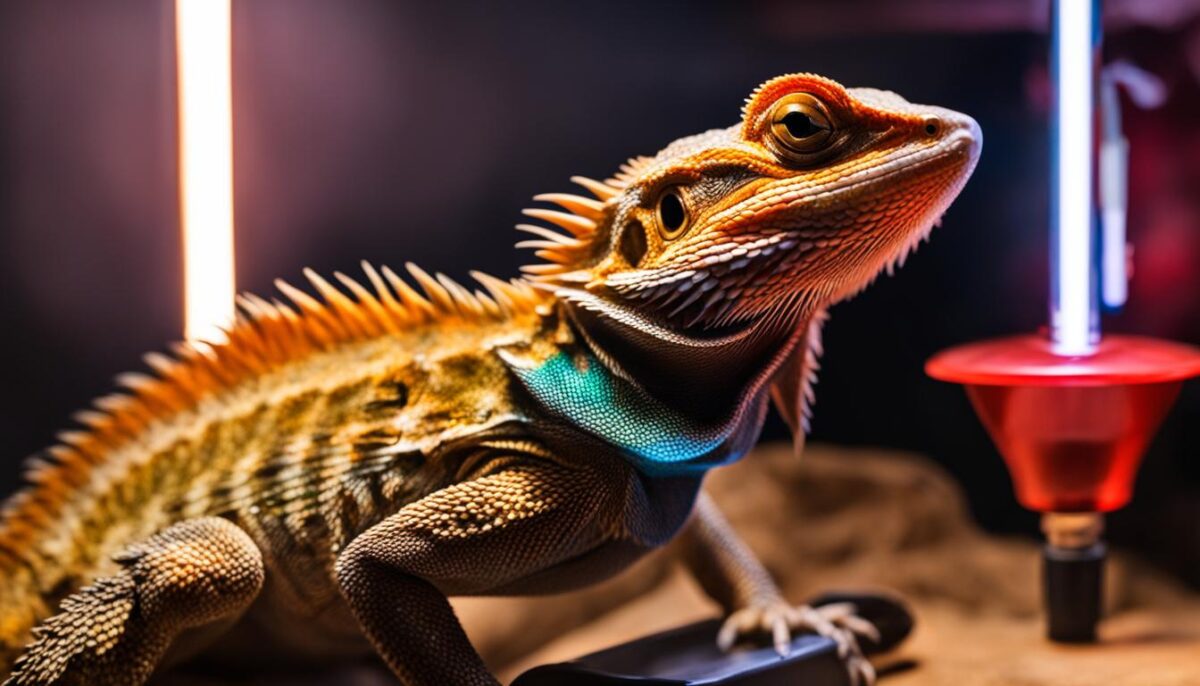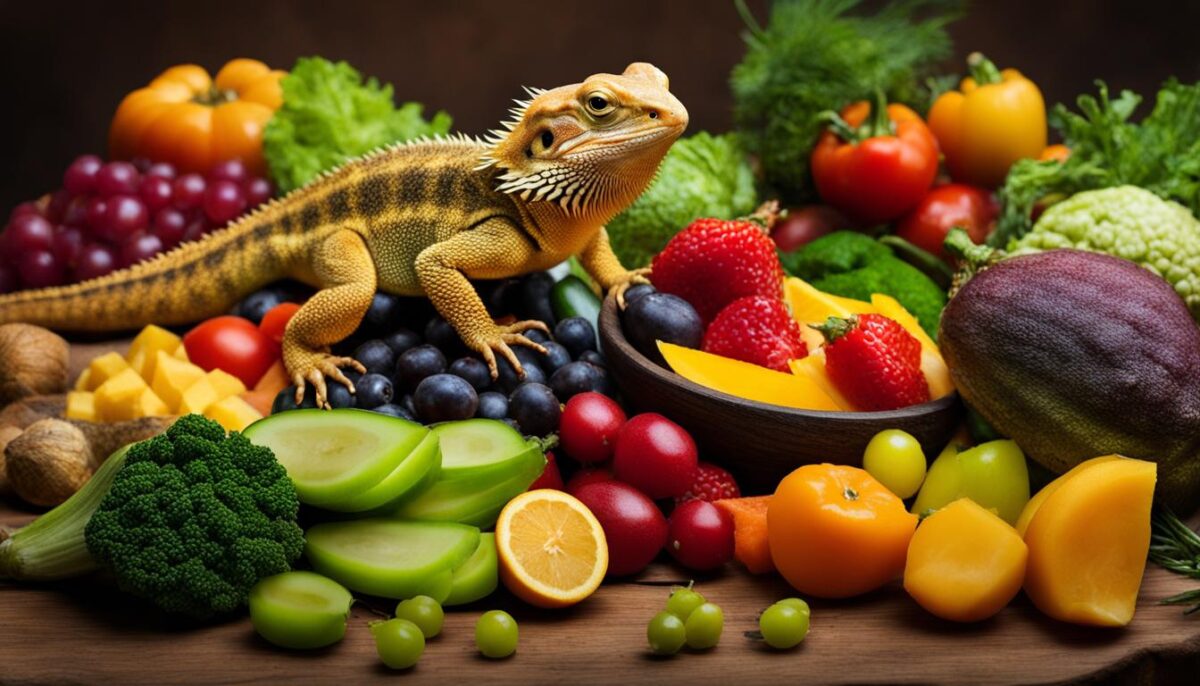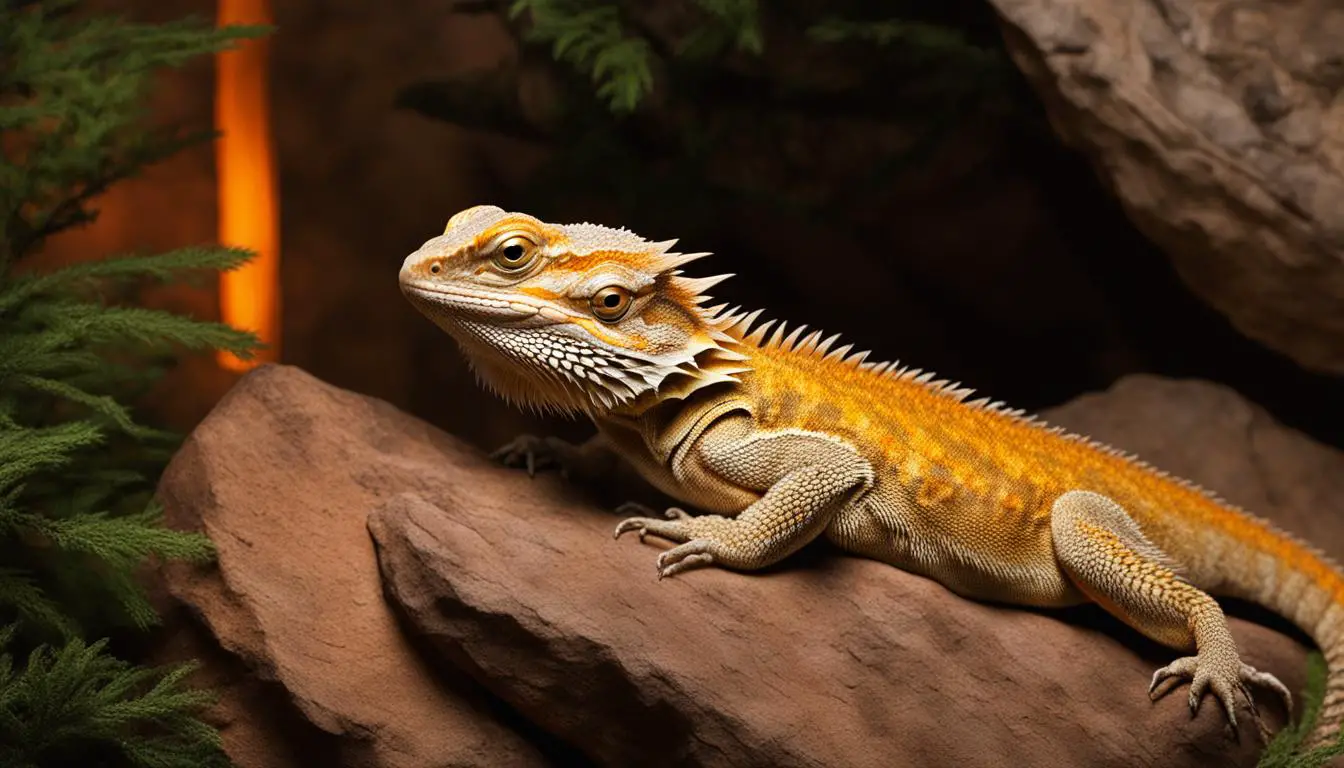Welcome to our guide on caring for your 3-year-old bearded dragon! Bearded dragons are wonderful pets that require specific care and attention to maintain their health and happiness. In this section, we will provide you with essential tips and information to ensure you can provide the best care for your beloved reptile friend.
Key Takeaways:
- Proper care and treatment are essential for the well-being of your 3-year-old bearded dragon.
- Bearded dragons are typically easy to handle and docile pets.
- They require appropriate housing, temperature regulation, UVB lighting, humidity control, enrichment, proper diet, and calcium and vitamin supplementation.
- Seek veterinary care when needed to maintain a healthy bearded dragon.
- By following these guidelines, you can ensure the continued health and happiness of your bearded dragon.
Bearded Dragon 3 Years Old
The Unique Features of Bearded Dragons
Bearded dragons are fascinating reptiles that possess unique features that set them apart from other pets. One of their most intriguing characteristics is their ability to change colors. These reptiles can have dual coloration, with two distinct tones on their body. This phenomenon is particularly evident in their scales and the area beneath their neck, which is often referred to as the “beard.”
The color change in bearded dragons occurs as a response to their mood or environment. It can be a form of communication with other bearded dragons or a defensive mechanism. When the reptile feels threatened or agitated, its scales may darken, creating a striking contrast between the different colors. This ability to change colors adds to the visual appeal of these already captivating creatures. Bearded Dragon 3 Years Old
In addition to color variation, bearded dragons also showcase different color types that have been developed through selective breeding. Breeders have successfully created vibrant yellow or orange variants that are highly sought after by reptile enthusiasts. Another unique color type is the leatherback, which features smooth scales instead of the typical spiked appearance. These multi-colored and smooth-scale variants further contribute to the remarkable beauty and diversity of bearded dragons. bearded dragon 2 different colors
Bearded dragons’ ability to change colors and the wide range of color variations make them truly fascinating pets to observe and care for. Their unique features contribute to their allure and appeal, enticing reptile enthusiasts worldwide.
Housing for 3-Year-Old Bearded Dragons
Proper housing is essential for the health and wellbeing of your 3-year-old bearded dragon. Providing a suitable enclosure will ensure they have enough space to move around comfortably and exhibit natural behaviors. A 75-gallon terrarium is the minimum size recommended for an adult bearded dragon, but a larger enclosure is always better. bearded dragon with dual coloration
When setting up the terrarium, make sure to include a screen top for proper ventilation. This will help maintain the ideal temperature and airflow within the enclosure. Additionally, bearded dragons need appropriate substrate to walk and lie on comfortably. Good options include tile, newspaper, indoor/outdoor carpeting, or reptile carpet. It is important to avoid using sand, fine gravel, wood chips, crushed walnut shells, or other substrates that could be ingested by your reptile.
Creating a stimulating environment is also important for the mental and physical wellbeing of your bearded dragon. Adding various decorations such as rocks, branches, and hiding spots will provide opportunities for climbing, exploring, and hiding. These enrichment activities will keep your pet engaged and prevent boredom.
Maintaining Proper Temperature for 3-Year-Old Bearded Dragons
Proper temperature regulation is crucial for the health and well-being of 3-year-old bearded dragons. These reptiles rely on their environment to regulate their internal body temperature, so it is essential to provide them with suitable temperature gradients within their enclosure. two-tone bearded dragon
During the daytime, the temperatures in the bearded dragon’s enclosure should range between 80 and 88 degrees Fahrenheit, with a designated basking spot that reaches 95 to 105 degrees. This basking area allows the bearded dragon to raise its body temperature as needed for digestion and other physiological processes. The cooler side of the enclosure should be around 70 degrees at night, providing a comfortable environment for sleep.
To achieve the appropriate temperatures, a reliable heat source is necessary. One popular option is a ceramic heat emitter, which emits infrared heat without emitting light, allowing for uninterrupted sleep cycles. It’s important to position the heat source in a way that creates a temperature gradient across the enclosure, with the basking spot being the warmest area. bearded dragon color variation
| Temperature: | Daytime Range: | Basking Spot: | Nighttime Range: |
|---|---|---|---|
| Minimum: | 80°F | 95°F | 70°F |
| Maximum: | 88°F | 105°F | 70°F |
Regular monitoring of the temperatures in the enclosure is essential to ensure they remain within the appropriate range. The use of thermometers is highly recommended to accurately measure and maintain the desired temperatures for the well-being of your 3-year-old bearded dragon.

Proper Basking Spot for 3-Year-Old Bearded Dragons
The basking spot is a critical element for maintaining proper temperature and allowing bearded dragons to thermoregulate effectively. It should be positioned in a way that provides a focused heat source for the bearded dragon to bask under. The basking spot can be created using a heat lamp or a ceramic heat emitter. multi-colored bearded dragon
The basking spot serves multiple purposes for the bearded dragon, including aiding digestion, promoting overall health, and allowing for proper UVB absorption. It’s essential to provide a suitable basking spot that reaches the recommended temperature range to support your bearded dragon’s well-being.
Remember to always consider the specific needs of your 3-year-old bearded dragon, as individual preferences and behaviors may vary. By maintaining proper temperature and providing a suitable basking spot, you can ensure the comfort and health of your bearded dragon. bearded dragon color change
Providing Ultraviolet Lighting for 3-Year-Old Bearded Dragons
Bearded dragons require ultraviolet light, specifically UVB, to properly process calcium and vitamin D. This light is crucial for their overall health and can prevent conditions like metabolic bone disease. UVB bulbs, such as Reptisun, should be placed no less than 12 inches from the basking site to prevent burns. It is important to replace UVB bulbs every six months to ensure proper output. bearded dragon morphs
To meet the lighting requirements of your 3-year-old bearded dragon, it’s essential to provide them with a quality UVB bulb. These bulbs mimic the natural ultraviolet light found in the reptile’s natural habitat and help them synthesize vitamin D3, which aids in calcium absorption. The Reptisun UVB bulb is a popular choice among reptile owners due to its effectiveness and reliability.
When setting up the UVB lighting in your bearded dragon’s enclosure, make sure to position the bulb at the appropriate distance from the basking spot. The bulb should be placed no closer than 12 inches to prevent the reptile from getting too close and potentially suffering burns. You can use a UVB meter to measure the output of the bulb and ensure it is providing the necessary UVB radiation for your bearded dragon’s well-being. bearded dragon color genetics
| Benefits of UVB Lighting for Bearded Dragons | Precautions |
|---|---|
| Stimulates the production of vitamin D3, which aids in calcium absorption for strong bones | Ensure the UVB bulb is the correct strength for the size of your bearded dragon |
| Helps prevent metabolic bone disease, a common condition in reptiles caused by calcium deficiency | Regularly check the UVB bulb’s output and replace it every six months |
| Supports overall health and well-being, including proper growth and reproduction | Position the UVB bulb at the recommended distance from the basking spot |
Remember to regularly monitor the UVB bulb’s output and replace it every six months, even if it appears to be working. Over time, the bulb’s UVB output diminishes, which could lead to a deficiency in your bearded dragon. By providing the proper ultraviolet lighting, you can ensure your 3-year-old bearded dragon thrives and remains healthy for years to come. rare bearded dragon color patterns
Maintaining Proper Humidity for 3-Year-Old Bearded Dragons
Proper humidity is essential for the health and well-being of 3-year-old bearded dragons. While they are native to desert environments, maintaining a humidity level of approximately 40–60% within their enclosure is crucial. This can be achieved by misting the enclosure with water daily and providing a shallow water bowl for hydration.
Bearded dragons may not drink directly from the water bowl, as they obtain most of their moisture from their diet. However, having a clean and accessible water source is important to prevent dehydration. Be sure to clean the water bowl regularly to maintain a healthy environment. If your bearded dragon is not drinking from the bowl, ensure their diet includes fresh vegetables and consider offering water-rich fruits like watermelon or cucumber as occasional treats.
It’s important to monitor humidity levels using a hygrometer to ensure they stay within the appropriate range. High humidity can lead to respiratory issues, while low humidity can result in dehydration and shedding problems. By providing the right humidity level, you can help your 3-year-old bearded dragon thrive in their environment. double colored bearded dragon
“Maintaining proper humidity is crucial for the overall health and well-being of 3-year-old bearded dragons. Be sure to monitor humidity levels and provide a clean water source for hydration.”

Humidity Requirements for Bearded Dragons
Bearded dragons require specific humidity levels to maintain their health. Here is a breakdown of the ideal humidity range for bearded dragons at different life stages:
| Life Stage | Ideal Humidity Range |
|---|---|
| Juvenile (0-1 year) | 30-40% |
| Sub-Adult (1-3 years) | 40-60% |
| Adult (3+ years) | 30-40% |
It’s important to note that maintaining proper humidity is just one aspect of caring for a 3-year-old bearded dragon. Providing appropriate housing, temperature regulation, lighting, and a balanced diet are all vital to their overall well-being. By ensuring all aspects of care are met, you can help your bearded dragon live a long, healthy life.
Enrichment for 3-Year-Old Bearded Dragons
Providing enrichment activities for your 3-year-old bearded dragon is essential for their overall well-being. These activities help stimulate their minds and provide necessary physical exercise. Here are some ways you can enrich your bearded dragon’s environment:
- Create hiding areas: Bearded dragons enjoy having places to retreat and feel secure. You can create hiding areas by placing caves or hollow logs in their enclosure. This allows them to choose a preferred temperature and light exposure.
- Add climbing opportunities: Bearded dragons are natural climbers and enjoy exploring their environment. Place thick branches or rocks in their enclosure to provide opportunities for climbing and perching. This will also help them exercise and maintain their muscle strength.
- Offer socialization time: While bearded dragons are typically solitary creatures, they can still benefit from limited socialization. You can gently handle and interact with your bearded dragon to help them become accustomed to human presence. This will help them feel more comfortable and reduce stress.
Remember that each bearded dragon is unique, so observe their preferences and adjust the enrichment activities accordingly. Providing a variety of enrichment options will keep your bearded dragon mentally stimulated and help prevent boredom.

Table: Sample Bearded Dragon Feeding Schedule
| Day | Morning | Afternoon | Evening |
|---|---|---|---|
| Monday | Insects (crickets or roaches) | Dark, leafy greens | Vegetables (carrots, squash) |
| Tuesday | Insects (hornworms or dubia roaches) | Fruits (small pieces as treats) | Dark, leafy greens |
| Wednesday | Insects (crickets or roaches) | Vegetables (broccoli, kale) | Dark, leafy greens |
| Thursday | Insects (hornworms or dubia roaches) | Fruits (small pieces as treats) | Vegetables (carrots, squash) |
| Friday | Insects (crickets or roaches) | Dark, leafy greens | Vegetables (broccoli, kale) |
Remember to provide fresh water in a shallow bowl daily, even though some bearded dragons may not drink directly from it. The combination of a balanced diet, proper hydration, and appropriate supplementation will help ensure that your 3-year-old bearded dragon remains healthy and happy for years to come.
Supplementing Calcium and Vitamins for 3-Year-Old Bearded Dragons
Proper supplementation of calcium, vitamins, minerals, and trace elements is essential for maintaining the health and wellbeing of 3-year-old bearded dragons. These supplements play a crucial role in supporting various bodily functions and addressing specific nutritional needs. It is important to follow veterinarian guidance on the appropriate dosage and frequency of supplementation to ensure optimal results.
Calcium Supplementation: Bearded dragons require adequate calcium levels to promote healthy bone development and prevent conditions such as metabolic bone disease. Calcium supplements can be dusted onto their food, ensuring that they consume the necessary amount. It is recommended to use calcium supplements that contain vitamin D3 to enhance calcium absorption.
Vitamin and Mineral Supplements: In addition to calcium, bearded dragons benefit from multivitamin supplements that provide essential nutrients. These supplements help fill any nutritional gaps in their diet and support overall health. Look for a reptile-specific multivitamin that is balanced and tailored to the needs of bearded dragons. Supplementation should be done according to the instructions provided by a reptile veterinarian.
Frequency and Monitoring: The frequency of calcium and vitamin supplementation may vary depending on the individual bearded dragon’s needs and overall diet. Generally, calcium supplements should be provided more frequently for growing dragons and pregnant females. It is important to monitor your bearded dragon’s behavior, appetite, and overall health to ensure that supplementation is effective and not excessive.
Conclusion
Proper care is essential for maintaining the health and wellbeing of your 3-year-old bearded dragon. By following a few key guidelines, you can ensure that your pet thrives and lives a long, happy life.
First and foremost, providing appropriate housing is crucial. Bearded dragons need a spacious terrarium with proper ventilation and the right substrate. Avoid substrates that can be ingested and cause harm to your dragon.
Temperature and lighting are also important factors to consider. Maintaining a temperature gradient and providing UVB lighting are necessary for your bearded dragon’s overall health and wellbeing.
In terms of diet, offer a balanced mix of animal protein and vegetables, making sure to include a variety of insects and dark, leafy greens. Remember to supplement their diet with calcium and vitamins for optimal health.
Lastly, enrichment activities such as climbing and providing hiding areas can keep your bearded dragon mentally stimulated. Just remember, they are solitary creatures and should not be housed together unless for breeding purposes.
By following these tips and seeking veterinary care when needed, you can ensure that your 3-year-old bearded dragon remains healthy and happy, providing you with years of enjoyment as a beloved pet.
FAQ
Can bearded dragons make good pets?
Yes, bearded dragons can make excellent, easy-to-care for pets if given appropriate care and veterinary treatment.
What is the average lifespan of a bearded dragon?
The average bearded dragon’s lifespan is 8–10 years, but the oldest ever recorded was 18 years old.
Are bearded dragons easy to handle?
Yes, bearded dragons are typically easy to handle, docile, and rarely bite.
How do bearded dragons change colors?
Bearded dragons can change colors and expand the scaled and spiked area below their neck, known as the “beard,” based on their mood or as a defensive mechanism.
What types of housing do bearded dragons require?
Bearded dragons require a minimum 75-gallon terrarium with proper ventilation. Acceptable substrates include tile, newspaper, indoor/outdoor carpeting, or reptile carpet.
How should the temperature be maintained for bearded dragons?
Bearded dragons require a temperature gradient with a warm side, a basking area, and a cool side. Daytime temperatures should be around 80–88 degrees Fahrenheit with a basking spot of 95–105 degrees.
What type of lighting do bearded dragons need?
Bearded dragons require UVB lighting to properly process calcium and vitamin D. UVB bulbs, such as Reptisun, should be placed no less than 12 inches from the basking site.
What humidity level do bearded dragons need?
Bearded dragons need a humidity level of approximately 40–60% within their enclosure. Fresh water should be provided in a shallow bowl for hydration.
What enrichment activities are beneficial for bearded dragons?
Providing burrows or hiding areas, thick branches or rocks for climbing, and access to preferred temperature and light exposure can keep bearded dragons mentally stimulated.
What should be included in a bearded dragon’s diet?
Bearded dragons require a balanced diet of approximately 25% insects, 50–55% vegetables, and limited fruits as treats.
Do bearded dragons need additional supplementation?
Yes, bearded dragons require additional supplementation of calcium, vitamins, minerals, and trace elements to support their overall health.


